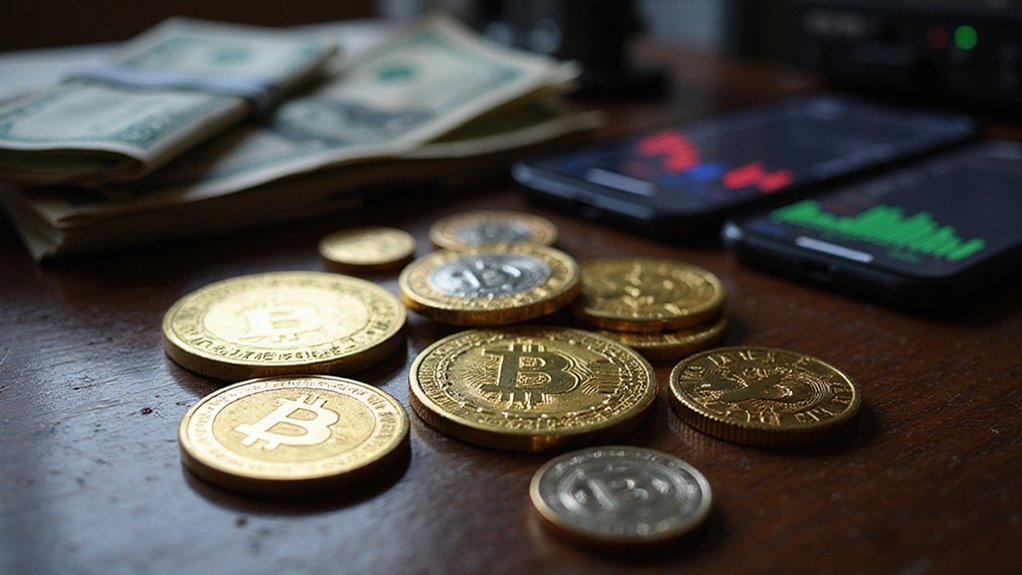Circulating supply represents the total cryptocurrency tokens actively available for trading, excluding locked, staked, or reserved coins that remain inaccessible to market participants. This metric directly influences price discovery and market capitalization calculations, though it masks underlying complexities like scheduled token releases, burn mechanisms, and inflationary mining rewards that continuously alter supply dynamics. While investors fixate on apparent scarcity, the relationship between circulating and total supply reveals deeper tokenomics truths worth exploring further.

The circulating supply of a cryptocurrency—that seemingly straightforward metric representing the total number of coins actively available for trading—carries far more weight in market dynamics than many investors initially realize.
This figure determines not merely availability but fundamentally shapes price discovery, market capitalization calculations, and investor psychology in ways that would make traditional economists reach for their calculators (and perhaps their antacids).
Market capitalization, that ubiquitous ranking metric beloved by crypto enthusiasts, emerges from the deceptively simple multiplication of circulating supply by current price.
That deceptively simple multiplication of circulating supply by current price masks considerable complexity beneath its ubiquitous ranking appeal.
Yet this calculation masks considerable complexity, as circulating supply fluctuates through mechanisms ranging from token burns—where developers effectively set money on fire to create artificial scarcity—to the gradual release of previously locked tokens that can flood markets with fresh supply.
The distinction between circulating and total supply reveals cryptocurrency’s peculiar relationship with transparency.
While total supply encompasses every coin ever created, circulating supply excludes locked, reserved, or otherwise inaccessible tokens.
This difference can create fascinating market distortions where investors price assets based on apparent scarcity, blissfully unaware of millions of tokens awaiting their inevitable market debut.
Mining and validation continuously introduce new coins into circulation, creating inflationary pressure that varies dramatically across different blockchain protocols. Miners compete to solve cryptographic puzzles that secure the network and validate transactions, earning newly created bitcoins as rewards for their computational efforts.
Some projects implement deflationary mechanisms through regular burn events, effectively playing monetary policy games that would make central bankers envious of such direct supply manipulation capabilities.
Bitcoin exemplifies how circulating supply caps can influence market perception and pricing dynamics.
Its predetermined maximum supply creates a scarcity narrative that has proven remarkably effective at driving investor demand, regardless of whether such artificial limitations actually enhance utility or value. Bitcoin’s circulating supply currently sits at approximately 19.5 million coins, demonstrating how close it has come to reaching its absolute maximum limit.
Understanding circulating supply becomes vital for calculating fully diluted valuation—a metric that assumes all possible tokens enter circulation simultaneously.
This theoretical exercise often reveals sobering realities about current valuations, particularly for projects with significant locked token reserves. Professional data labeling services become essential for accurately categorizing and tracking these complex token release schedules across different cryptocurrency projects.
Investors who focus exclusively on current market caps while ignoring future supply releases may discover that their “scarce” assets become considerably less rare over time, a lesson that transforms portfolio management from art into survival strategy.
Frequently Asked Questions
How Often Do Cryptocurrency Exchanges Update Their Circulating Supply Data?
Cryptocurrency exchanges typically update their circulating supply data every five minutes, though this frequency depends on API availability from project teams and platform-specific rate limitations.
Major platforms like CoinGecko maintain this schedule to guarantee accurate market capitalization calculations, while others may update less frequently.
The irony? Despite blockchain’s immutable nature, these supply metrics require constant manual oversight—a rather analog solution for digital assets that supposedly eliminate intermediaries.
Can Circulating Supply Decrease Permanently for a Cryptocurrency?
Yes, circulating supply can decrease permanently through token burn mechanisms, where tokens are sent to inaccessible addresses and destroyed forever.
Unlike staking (which temporarily locks tokens), burns create irreversible scarcity by reducing total supply.
Projects like Binance Coin systematically burn tokens quarterly, permanently shrinking circulation.
This deflationary approach theoretically increases remaining tokens’ value—though whether markets actually respond rationally remains perpetually debatable in crypto’s often bewildering ecosystem.
What Happens to Price When Circulating Supply Suddenly Increases Dramatically?
When circulating supply suddenly increases dramatically, downward price pressure typically intensifies as basic supply-demand dynamics take hold.
The severity depends on market demand strength and investor sentiment—strong demand can absorb additional tokens, while weak markets amplify the decline.
Market cap calculations shift unfavorably, often triggering algorithmic selling and panic responses.
The timing proves particularly cruel, as these increases frequently coincide with already bearish conditions, creating cascading effects that humble even seasoned traders.
Do Staked Tokens Count Toward a Cryptocurrency’s Circulating Supply?
Staked tokens typically don’t count toward circulating supply, since they’re locked in contracts and temporarily unavailable for trading.
This classification varies by project—some protocols exclude all staked tokens, while others (rather confusingly) include partially liquid staking derivatives.
The distinction matters considerably for market calculations, as removing millions of tokens from circulation can artificially inflate scarcity metrics and distort price-to-supply ratios that investors rely upon for valuation assessments.
Which Websites Provide the Most Accurate Circulating Supply Information?
CoinMarketCap and CoinGecko dominate circulating supply accuracy through extensive blockchain monitoring and exchange partnerships.
BitDegree’s coverage of 21,000+ cryptocurrencies offers thorough data, while Coinlib provides reliable real-time updates.
However, accuracy varies considerably across tokens—particularly newer projects with complex tokenomics.
CoinMarketCap’s rigorous verification process generally yields superior reliability, though savvy investors cross-reference multiple sources since even established platforms occasionally display discrepancies during major token events or protocol upgrades.









